Bike pedals are a crucial component for any cyclist, acting as the primary interface between you and your bike. They are more than just platforms to rest your feet; they are essential for power transfer, control, and overall riding efficiency. Choosing the right bike pedals can significantly enhance your cycling experience, whether you’re a casual commuter, a mountain trail enthusiast, or a competitive road cyclist.
This guide dives deep into the world of bike pedals, exploring the best options across different categories. We’ll cover flat pedals, clipless mountain bike pedals, and road bike pedals, highlighting top-performing models based on rigorous testing and expert reviews. Whether you’re upgrading your current setup or outfitting a new bike, understanding the nuances of each pedal type will help you make an informed decision and select the Best Bike Pedals for your specific needs and riding style.
CXWXC CX-930 Pedals
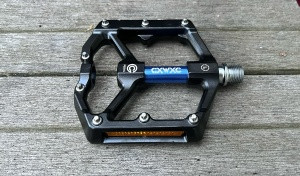 CXWXC CX-930 Pedals
CXWXC CX-930 Pedals
OVERALL SCORE: 66
- Grip and Traction: 6.0
- Platform: 7.0
- Mobility: 6.0
- Servicing: 6.0
- Weight: 8.0
Weight per pair: 365 grams | Traction pins: 8 per side
REASONS TO BUY
- Excellent value
- Solid platform
- Durable
REASONS TO AVOID
- Inferior grip
- Prone to pedal strikes
The CXWXC CX-930 pedals are a surprisingly budget-friendly option that doesn’t skimp entirely on features. These flat pedals offer a wide, concave platform and integrated reflectors, making them a practical choice for everyday cycling. While their grip may not be top-tier compared to more specialized mountain bike pedals, they provide reliable performance for commuting and recreational riding. Our testing on both mountain bikes and commuter bikes revealed their versatility, excelling particularly on electric bikes and commuter setups where power transfer and visibility are key.
The larger platform size of the CX-930 contributes to efficient power delivery, a noticeable advantage for commuters and e-bike riders. The hex traction pins offer sufficient grip for various shoe types, accommodating the diverse footwear choices of daily commuters. For cyclists seeking an upgrade from basic stock pedals, the CXWXC CX-930 presents a durable, wider platform with enhanced traction at an accessible price point, particularly well-suited for e-bikes and commuting.
A notable aspect of the CXWXC CX-930 Pedals is their installation requirement: an 8mm hex Allen key is necessary, as they lack wrench flats common on many pedals. Furthermore, while functional, their grip doesn’t match that of dedicated entry-level flat pedals designed for aggressive riding. However, this is balanced by the larger platform and built-in reflectors, catering specifically to commuters and those prioritizing versatility over maximum grip for demanding trails. Ultimately, the CXWXC CX-930 pedals offer a valuable proposition for riders needing robust flat pedals for commuting and e-biking, blending practicality with affordability.
Race Face Chester: Best Everyday Flat Pedal
OVERALL SCORE: 74
- Grip and Traction: 7.0
- Platform: 7.0
- Mobility: 8.0
- Servicing: 7.0
- Weight: 8.0
Weight: 358 grams | Traction: 8 pins per side
REASONS TO BUY
- Economical
- Sturdy
- Nice size platform
REASONS TO AVOID
- Axle lacks traction pins
- Eight traction pins per side
The Race Face Chester pedals consistently score high in our tests and represent exceptional value. While recognized in our Mountain Bike Flat Pedals review, their versatility extends seamlessly to everyday commuting and leisurely rides around town, making them excellent best bike pedals for multiple uses. Constructed with a durable nylon composite body, the Chester features a comfortable 101x110mm platform with a slim 14mm profile. The tapered edges are designed to minimize pedal strikes, a feature that proved effective in our testing, where the Chester outperformed other nylon pedals in avoiding ground contact. Eight strategically placed traction pins along the pedal perimeter offer reliable grip when your foot is well-positioned. However, the absence of pins near the axle can be a drawback in muddy conditions. We appreciate the Chester’s full serviceability and readily available replacement parts from numerous online retailers, enhancing its long-term value.
Despite its strengths, the lack of axle pins on the Chester can compromise grip in muddy conditions, emphasizing the need for precise foot placement, especially on challenging terrain. Riders with larger feet might find the pedal body lacking in lateral support. Nevertheless, the Chester delivers solid all-around performance, particularly for budget-conscious cyclists seeking reliable flat pedals for varied riding scenarios. For riders with larger shoe sizes needing more platform, the OneUp Composite offers a significantly larger platform at a comparable price point.
Read more: Race Face Chester review
 Race Face Chester platform and grip
Race Face Chester platform and grip
This budget-friendly nylon pedal has a nice sized platform and offers good grip while riding.
Fooker Nylon Fiber: Most Affordable Everyday Pedal
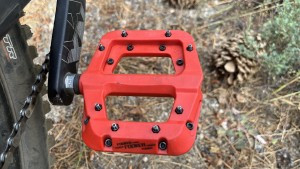 Fooker Nylon Fiber Pedals
Fooker Nylon Fiber Pedals
OVERALL SCORE: 71
- Grip and Traction: 7.0
- Platform: 6.0
- Mobility: 8.0
- Servicing: 7.0
- Weight: 8.0
Weight: 370 grams | Traction: 8 pins per side
REASONS TO BUY
- Economical
- Easy to adjust foot
- Replaceable pins
REASONS TO AVOID
- Devoid of axle pins
- Lower quality finish on axle and dust cap
The Fooker Nylon Fiber pedals stand out as one of the most economical options in our test without sacrificing essential performance. These best bike pedals feature a 110mm x 100mm platform, available in six colors, each equipped with eight bottom-loading traction pins per side. These pins provide effective grip while allowing for easy foot adjustments, complemented by the pedal’s smooth axle rotation. The Fooker Nylon is offered in two bearing configurations: one with three sealed bearings and a slightly pricier version with two needle roller bearings. The latter boasts higher load ratings and a dust cap on the axle, enhancing durability.
Our evaluation focused on the Fooker Nylon Fiber pedal with three sealed bearings. During servicing, we observed that the axle and end cap finish quality is somewhat lower compared to pricier pedals. However, this didn’t translate to performance issues during our testing. We confidently recommend these pedals for cyclists seeking an affordable nylon flat pedal that balances good traction and foot mobility effectively. For riders prioritizing top-tier flat pedal performance and materials over budget considerations, the premium Wolf Tooth Waveform is a worthy upgrade.
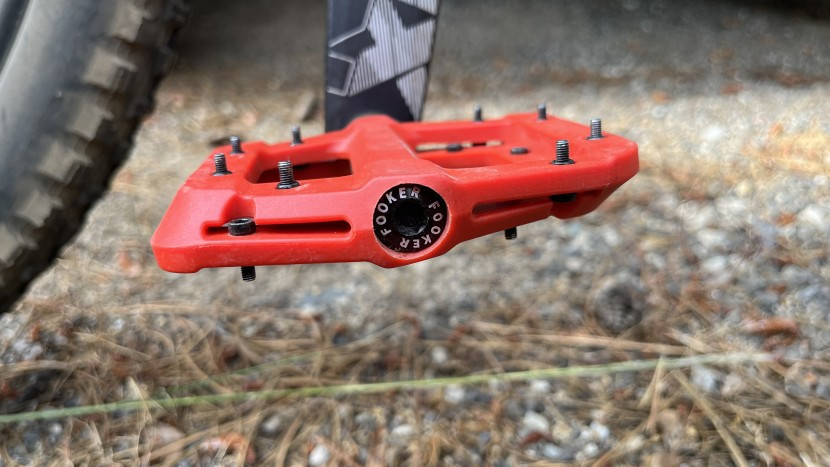 Fooker Nylon Fiber pedal close-up
Fooker Nylon Fiber pedal close-up
This cost-conscious pedal looks similar to more expensive pedals and blends good mobility and grip.
Wolf Tooth Waveform: Best Overall Flat Pedal
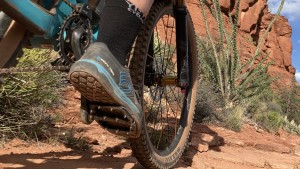 Wolf Tooth Waveform Pedals
Wolf Tooth Waveform Pedals
OVERALL SCORE: 81
- Grip and Traction: 9.0
- Platform: 8.0
- Mobility: 8.0
- Servicing: 7.0
- Weight: 8.0
Weight: 373 grams | Traction: 11 pins per side
REASONS TO BUY
- Natural feeling platform
- Outstanding grip
- Weight
- Parts available
REASONS TO AVOID
- Steep price tag
The Waveform pedal from Wolf Tooth Components truly impressed our testers, earning its place as the best overall flat pedal. Its exceptional combination of a natural-feeling platform, superior grip, and ease of maintenance sets it apart as a top performer in our mountain bike flat pedal tests and generally as best bike pedals in the flat category. The Waveform features a dual-concave aluminum platform equipped with 11 bottom-loading traction pins, delivering outstanding grip with various flat pedal shoes. These pins provide a secure and confident feel for both climbing and descending, yet allow for subtle foot adjustments when needed. The aluminum pedal body incorporates tapered edges to deflect impacts on rocky trails, although the leading and trailing edge pins can be susceptible to bending. Available in two sizes, small and large, the Waveform allows riders to optimize pedal size according to their foot size and terrain. Servicing the Waveform, including bearings, is straightforward, requiring only three Allen keys. Wolf Tooth’s commitment to “Right to Repair” ensures full rebuildability with all components available as replacement parts, extending the pedal’s lifespan indefinitely.
The primary drawback of the Waveform is its higher price point. However, this initial investment is mitigated by its full rebuildability and the availability of replacement parts—including the pedal body, bushings, pins, and seals—directly from Wolf Tooth, significantly prolonging its lifespan. The dual-concave platform may not suit every rider’s preference; some may find their foot sinking too deeply and prefer a flatter or convex profile. Despite this, the Waveform’s exceptional traction, platform feel, lightweight design, and serviceability make it one of the most impressive pedals we’ve evaluated. For riders seeking similar high-performance attributes at a more accessible price, the HT Components ANS10 Supreme is a strong alternative.
Read more: Wolf Tooth Waveform review
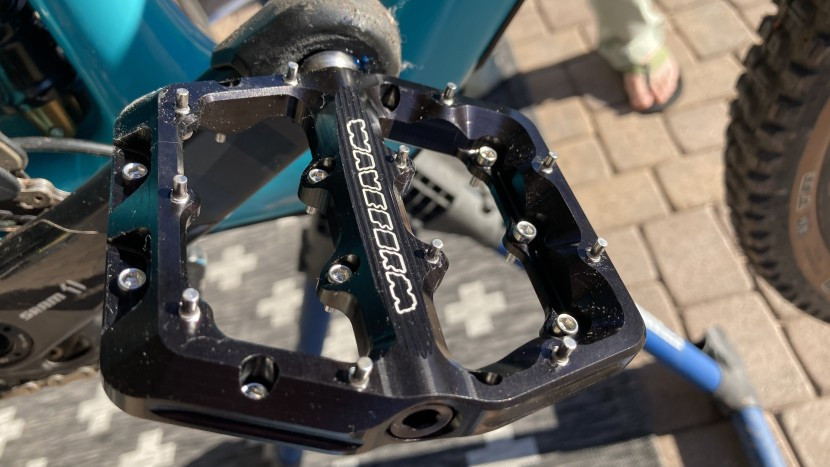 Wolf Tooth Waveform grip and natural feel
Wolf Tooth Waveform grip and natural feel
These pedals impressed us with how natural they feel underfoot and for their exceptional grip.
OneUp Components Composite: Best Large Platform Flat Pedal
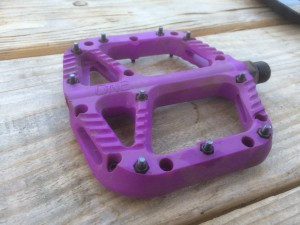 OneUp Components Composite Pedals
OneUp Components Composite Pedals
OVERALL SCORE: 73
- Grip and Traction: 6.0
- Platform: 7.0
- Mobility: 8.0
- Servicing: 8.0
- Weight: 8.0
Weight: 359 grams | Traction: 10 pins per side
REASONS TO BUY
- Budget price
- Good performance
- Serviceable
- Light
REASONS TO AVOID
- Servicing requires a deep socket
- Thick at axle
For riders prioritizing a larger pedal platform without breaking the bank, the OneUp Composite pedals are an excellent choice and are considered best bike pedals for large feet. Uniquely, the Composite features a convex shape, with the axle positioned slightly higher than the pedal’s edges, mimicking the natural arch of the foot—a preference for some riders over concave designs. The generous 114mm x 104mm platform makes the Composite particularly suitable for cyclists with larger shoe sizes. Ten traction pins, distributed along the perimeter and axle, provide dependable grip even on technical terrain and steep descents, especially when actively weighting the pedals. Foot repositioning remains easy with slight unweighting, and the bearings strike a good balance with minimal drag. Despite its robust platform, the composite material effectively withstands rock strikes.
However, the budget-friendly Composite pedals do have a couple of minor drawbacks. At 16.8mm thickness at the axle and 13.8mm at the edges, they aren’t the thinnest option for riders seeking a low-profile pedal. While serviceable with available bearings and replacement pins, maintenance requires a 9mm deep socket to access the axle nut—a tool not always standard in home toolboxes. Nevertheless, these drawbacks are minor considering the pedal’s strengths, especially if platform size, durability, and affordability are top priorities. If a similarly priced pedal with a smaller platform is preferred, the Race Face Chester is a worthy alternative.
Read more: OneUp Components Composite review
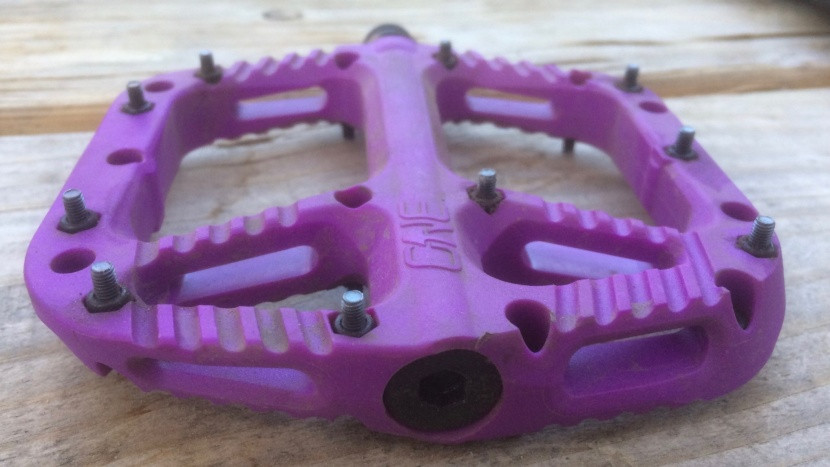 OneUp Components Composite large platform
OneUp Components Composite large platform
This pedal features a large platform, making it a great choice for riders with a larger shoe size.
HT Components T2: Best Overall Mountain Bike Pedal
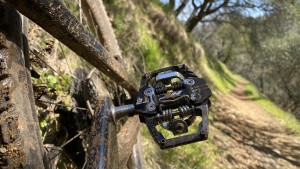 HT Components T2 Pedals
HT Components T2 Pedals
OVERALL SCORE: 87
- Ease of Exit: 8.0
- Ease of Entry: 9.0
- Adjustability: 10.0
- Weight: 8.0
- Platform: 8.0
- Mud Shedding Ability: 9.0
Weight: 380 grams | Profile Height: 17 millimeters
REASONS TO BUY
- Excellent stability
- Easy to clip in
- Two sets of cleats included
REASONS TO AVOID
- Costly
- Unclipping takes practice
The HT Components T-2 pedals impressed our testers with their wide platform and exceptional mud-shedding capabilities, securing their position as a top choice for clipless mountain bike pedals and best bike pedals in the clipless MTB category. Weighing 380 grams per pair, the T-2 features a stable aluminum platform with a CNC-machined Chromoly spindle, incorporating smooth bearings and bushings. Clipping in is remarkably easy, aided by four grub screws that guide the cleat precisely into place. We particularly appreciate the adjustability of both the grub screws and the release tension, which ranges from very light to securely locked-in. Increasing the release tension provides a firmer hold, requiring more deliberate heel movement to unclip, accompanied by an audible click for confirmation. Catering to rider preference, the T-2 includes two cleat sets: one offering four degrees of float and another with eight degrees.
The T-2 utilizes a retention bar at the front and a floating rear retainer. New users should practice unclipping to become accustomed to the floating rear retainer’s release mechanism, which differs from other pedal designs. The HT cleat is slightly larger than some brands, yet we experienced no compatibility issues with various test shoes. However, riders with shoes having narrow cleat openings should verify fitment. For those seeking high-performance clipless mountain bike pedals with a stable platform and extensive adjustability, the T-2 is an outstanding option. A comparable alternative, lacking the floating rear retainer, is the Shimano PD-M8120 XT SPD, known for its redesigned, slimmer profile and proven reliability.
Read more: HT T-2 review
 HT Components T2 adjustability and platform
HT Components T2 adjustability and platform
This is one of our top picks for a clipless pedal, it has great adjustability, a stable platform, and excellent mud-shedding properties.
Shimano ME700: Best Budget Mountain Bike Pedal
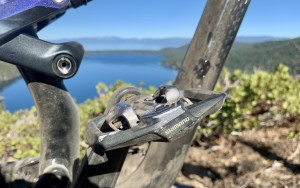 Shimano ME700 Pedals
Shimano ME700 Pedals
OVERALL SCORE: 75
- Ease of Exit: 8.0
- Ease of Entry: 8.0
- Adjustability: 8.0
- Weight: 5.0
- Platform: 8.0
- Mud Shedding Ability: 7.0
Weight: 482 grams | Profile Height: 19 millimeters
REASONS TO BUY
- Economical
- Adjustability
- User friendly
REASONS TO AVOID
- Platform surface is slippery when wet
- Holds mud
- Weight
The Shimano ME700 pedals offer clipless pedal benefits with a large, stable platform, user-friendliness, and adjustability at a modest price, making them ideal best bike pedals for budget-conscious mountain bikers. The ME700 incorporates features similar to Shimano’s higher-end pedals, such as 20 clicks of adjustable tension for easy and customizable engagement and release. Shimano’s dependable SPD clipless mechanism is surrounded by a 100mm x 74mm painted aluminum mini-cage, which aids cleat guidance during entry and provides lateral stability. Like other Shimano SPD pedals, the ME700 is dual-sided for convenient clip-in from either side and can be installed using a 6mm Allen wrench or a 15mm open-ended wrench.
During testing, we observed that the ME700’s painted mini-cage tended to retain more mud compared to machined and anodized cages. However, the core SPD mechanism remained reliable in muddy conditions. The main drawback of the ME700 is its weight—482 grams per pair—which might be considered heavy by weight-sensitive riders. Overall, this pedal offers excellent performance for its price point, making it a strong budget-friendly clipless option. For those seeking an upgraded version of the ME700 with a machined cage, the Shimano PD-M8120 XT SPD is recommended.
Read more: Shimano ME700 review
This budget-friendly pedal uses similar technologies to it’s more expensive siblings, and performs very well.
Shimano PD-M8120 XT SPD: An Extra Durable Mountain Bike Pedal
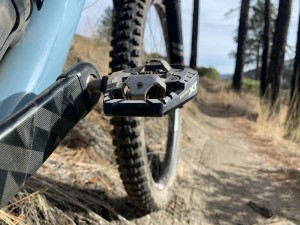 Shimano PD-M8120 XT SPD Pedals
Shimano PD-M8120 XT SPD Pedals
OVERALL SCORE: 81
- Ease of Exit: 8.0
- Ease of Entry: 9.0
- Adjustability: 8.0
- Weight: 7.0
- Platform: 8.0
- Mud Shedding Ability: 8.0
Weight: 430 grams | Profile Height: 18 millimeters
REASONS TO BUY
- Stable platform
- Durable
- Good value
REASONS TO AVOID
- No float adjustment
The redesigned Shimano M8120 XT pedals feature a slimmer profile and a larger platform than previous iterations while maintaining the renowned durability and predictable performance of the XT series, making them best bike pedals for durability. The anodized platform, measuring 100mm x 71mm, provides an excellent shoe-pedal interface, enhancing lateral stability and overall bike control. A machined aluminum platform section offers additional grip when clipping into the reliable SPD clipless mechanism. The SPD system is known for its consistent and predictable engagement, featuring 20 clicks of tension adjustment from very light to very stiff release, activated by a heel twist with an audible click. The machined platform’s mud-shedding design and the SPD mechanism’s resistance to clogging are beneficial for riding in muddy conditions.
A minor point is the pedal’s locknut, which slightly protrudes above the platform when tightened to Shimano specifications, potentially causing some resistance in pedal float. This can be adjusted by slightly altering the locknut torque. The M8120 XT lacks float adjustment, but an alternative cleat allowing upward release is available separately. We found the M8120 XT to be exceptionally durable, surpassing even more expensive siblings in longevity, making it an excellent choice for riders needing long-lasting clipless pedals capable of withstanding years of demanding use. For those who appreciate Shimano’s design but seek a more budget-friendly option, the Shimano ME700 offers the same SPD clipless mechanism with a painted pedal body.
Read more: Shimano PD-M8120 XT SPD review
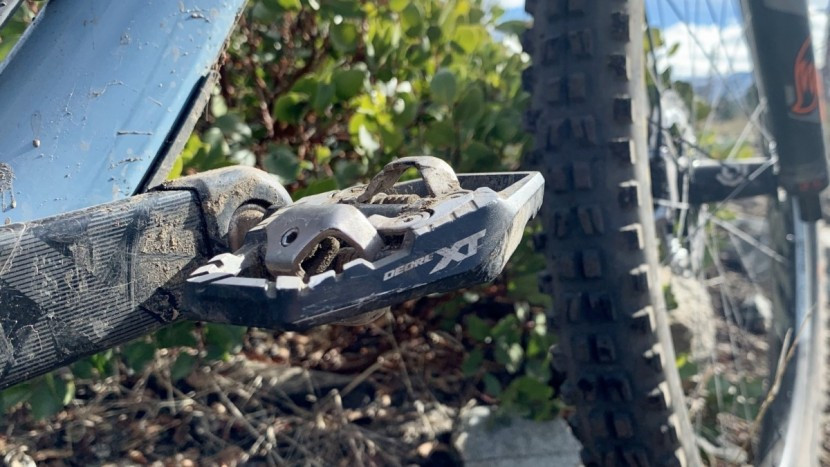 Shimano PD-M8120 XT SPD slimmer profile
Shimano PD-M8120 XT SPD slimmer profile
The redesigned XT is as durable as ever but now has a slimmer profile.
Shimano Ultegra PD-R8000 SPD-SL: Best Overall Road Bike Pedal
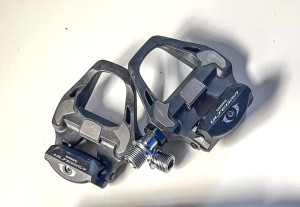 Shimano Ultegra PD-R8000 SPD-SL Pedals
Shimano Ultegra PD-R8000 SPD-SL Pedals
OVERALL SCORE: 83
- Ease of Entry: 8.0
- Ease of Exit: 8.0
- Adjustability: 8.0
- Weight: 9.1
- Platform: 8.0
- Build Quality: 9.0
Weight: 320 grams | Stack Height: 16 millimeters
REASONS TO BUY
- Light
- Carbon composite body
- High-performance bearings
REASONS TO AVOID
- Pricey
- Stack height is high
The Shimano Ultegra PD-R8000 SPD-SL pedals are our top pick for road cyclists seeking lightweight design combined with reliable, high-level performance and best bike pedals overall for road cycling. This latest Ultegra iteration utilizes an extra-wide carbon composite body with a stainless steel plate, enhancing stability, reducing flex, and maximizing power transfer. The carbon and stainless steel combination boosts durability while minimizing weight, resulting in a mere 320 grams per pair. Internally, smooth, durable sealed bearings are strategically positioned to evenly distribute load. Adjustable release tension allows riders to fine-tune clip-out force, and engagement and release remain consistently predictable and smooth, regardless of cleat wear. We also appreciate the Ultegra PD-R8000’s availability in two Q-Factors, enabling riders to select the optimal axle length for their knee biomechanics.
The Ultegra PD-R8000’s single-sided entry might be a minor drawback for road cyclists who prefer double-sided pedals, and its 16mm stack height is not exceptionally low. The other primary downside is the higher price. However, these pedals are engineered for longevity and performance. For road cyclists willing to invest in their pedal system, the durable and dependable Ultegra PD-R8000 is an excellent choice. For similar performance at a more budget-friendly price, consider the Look Keo Classic 3.
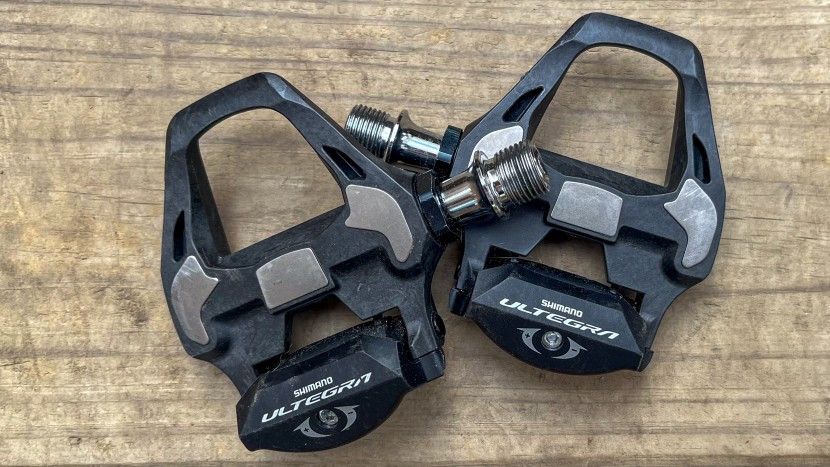 Shimano Ultegra PD-R8000 SPD-SL durability and performance
Shimano Ultegra PD-R8000 SPD-SL durability and performance
These pedals are not only durable but they have reliable performance.
Look Keo Classic 3: Best Budget Road Bike Pedal
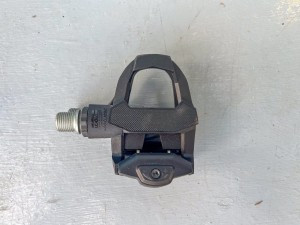 Look Keo Classic 3 Pedals
Look Keo Classic 3 Pedals
OVERALL SCORE: 75
- Ease of Entry: 8.0
- Ease of Exit: 8.0
- Adjustability: 7.0
- Weight: 7.1
- Platform: 7.0
- Build Quality: 7.0
Weight: 348 grams | Stack Height: 17.8 millimeters
REASONS TO BUY
- Proven design
- Easily adjustable release tension
- Economical
REASONS TO AVOID
- Cleats wear down quickly
- Plastic composite body
Look’s Keo Classic 3 pedals represent a budget-conscious road bike pedal option that delivers stable performance with a plastic platform and adjustable tension, making them best bike pedals for budget road cyclists. Adjustable release tension makes clipping out smooth and straightforward. The Keo Classic 3 comes with Look’s GRIP cleat, featuring a TPU layer on the shoe side to prevent slippage on carbon soles. The included grey GRIP cleat offers 4.5 degrees of lateral float, and additional cleat options are available with zero and nine degrees of float. Throughout our testing, the Keo Classic 3 performed comparably to more expensive Look offerings.
However, there are some trade-offs with this budget-oriented pedal. Look GRIP cleats are known to wear relatively quickly, and the plastic composite body is less robust than stainless steel or carbon composite alternatives. We recommend using cleat covers when walking to extend cleat life. The Keo Classic 3 also offers less tension release adjustment and has a smaller platform, resulting in a reduced contact area between shoe and pedal. Despite these minor limitations, the Classic 3 is a very capable pedal, particularly for those prioritizing budget and performance, or for cyclists new to clipless road pedals. For riders seeking a road pedal with a metal body, the Look Keo 2 Max is a top-rated alternative.
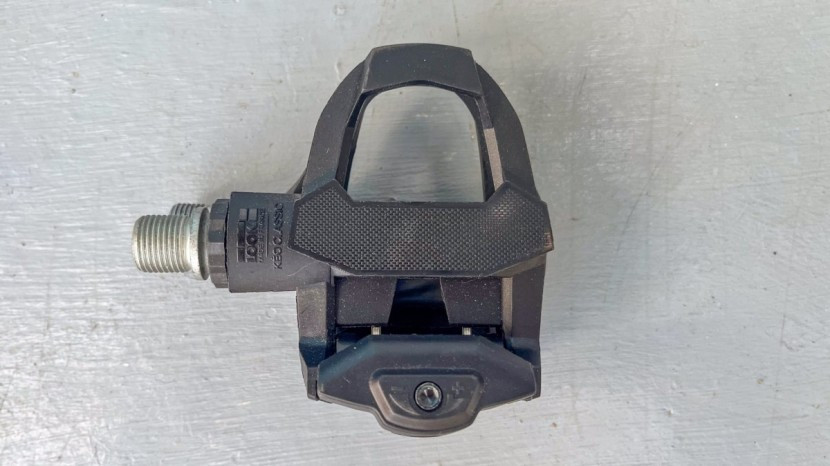 Look Keo Classic 3 impressive performance
Look Keo Classic 3 impressive performance
This pedal has impressive performance.
Wahoo Fitness Speedplay Comp: Best Road Bike Pedal for Adjustability
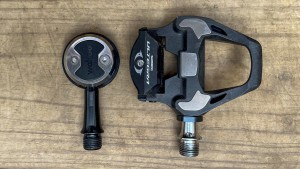 Wahoo Fitness Speedplay Comp Pedals
Wahoo Fitness Speedplay Comp Pedals
OVERALL SCORE: 81
- Ease of Entry: 9.0
- Ease of Exit: 9.0
- Adjustability: 9.0
- Weight: 5.3
- Platform: 7.0
- Build Quality: 8.0
Weight: 374 grams | Stack Height: 11.5 millimeters
REASONS TO BUY
- Great adjustability
- Two-sided entry
- Very low stack height
REASONS TO AVOID
- Small platform
- Costly cleats
For cyclists requiring or preferring extensive float or double-sided entry in their road bike pedals, the Wahoo Fitness Speedplay Comp stands out as an excellent choice and best bike pedals for adjustability. The Speedplay Comp uniquely offers zero to 15 degrees of float, providing a wide range of motion between knee and foot—particularly beneficial for riders struggling with leg alignment issues. The included “Easy Tension” cleat allows for fore-aft, left-right, and rotational adjustments, enabling riders to precisely dial in the pedal system to their individual biomechanics. The Speedplay Comp also features a very low 11.5mm stack height, positioning the foot closer to the pedal axle for enhanced power transfer. These features combine to make it one of the most highly adjustable road pedals available. However, optimal performance relies on meticulous setup.
Speedplay’s “Comp” cleat is included with the pedal and provides the lightest release tension in their range. The pedal is also compatible with Speedplay’s “Standard” tension cleat, offering increased release force, but this is an additional purchase. The cleat design is somewhat prone to collecting dirt and debris, potentially hindering clip-in and necessitating cleat covers for walking. For riders using softer-soled shoes, the pedal feel might be noticeable on longer rides despite the large cleat. For those prioritizing maximum adjustability for biomechanics or double-sided entry, the Wahoo Fitness Speedplay Comp is highly recommended. If the Speedplay design isn’t ideal, the Shimano Ultegra PD-R8000 SPD-SL offers reliable performance with a carbon body as a strong alternative.
Read more: Wahoo Fitness Speedplay Comp review
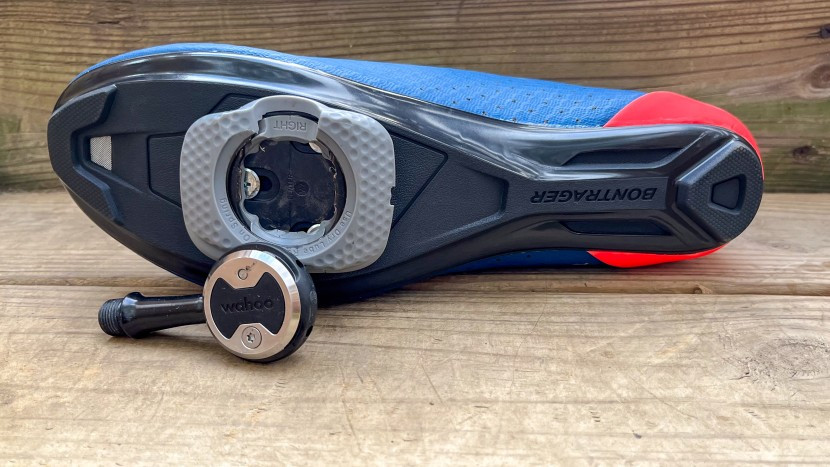 Wahoo Fitness Speedplay Comp adjustability and low stack height
Wahoo Fitness Speedplay Comp adjustability and low stack height
The Comp provides tons of adjustment and float and has a low stack height, meaning less space between your shoe and the pedal’s axle.
How We Test Bike Pedals
Our bike pedal reviews are built upon the expertise of seasoned industry professionals, including professional and amateur racers, bike shop owners, and mountain bike coaches, collectively bringing over 50 years of cycling experience to our testing process. For each pedal category, we conduct thorough market research, examining both established models and new releases across various price points. We then carefully select and purchase test models for extensive hands-on evaluation. Each pedal type has its unique set of performance metrics, tailored to its intended use. Our testing often involves riding with different pedals on each crank arm or swapping pedals mid-ride to facilitate direct, real-time performance comparisons. We also meticulously weigh and disassemble each pedal pair to assess construction quality and serviceability. Following comprehensive testing, we assign a score to each pedal across our metrics, culminating in an overall score. This detailed methodology ensures our reviews provide valuable, data-driven insights into each pedal’s performance characteristics.
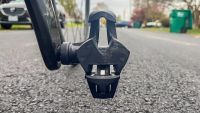 Bike pedal testing in real-world conditions
Bike pedal testing in real-world conditions
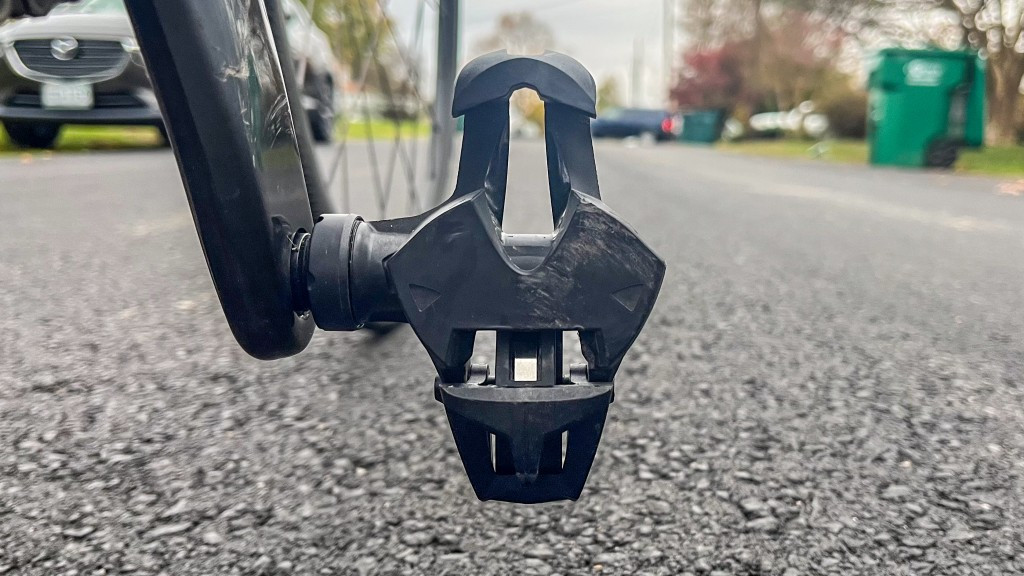 Muddy bike pedal testing
Muddy bike pedal testing
Why Trust GearLab
Our bike pedal reviews are informed by an all-star team of road cyclists and mountain bikers. Luke Hollomon spearheads our road bike pedal testing. Luke, a physical therapist, has competed in diverse cycling disciplines for two decades. He embraces a car-free lifestyle for 90% of his travel, riding daily and often towing his dog Kiwi in a trailer.
For mountain bike pedal evaluations, we rely on the expertise of Joshua Hutchens and Tara Reddinger-Adams. Joshua has been in the bike industry since age 12, growing up racing BMX and has experience across all cycling disciplines, with a passion for mountain biking. He previously owned a boutique bike shop in the Pacific Northwest, recognized multiple times as one of “America’s Best Bike Shops” by Bicycle Retailer, and later founded Lumberwood Indoor Bike Park. He now resides in South Lake Tahoe, enjoying trails and family time. Tara’s background is in educational leadership, but her passion led her to 11 years in a bike shop, mastering sales and maintenance. She became a certified mountain bike coach and guide, owning her coaching business. Tara is an avid traveler and explorer, sharing her love for mountain biking globally.
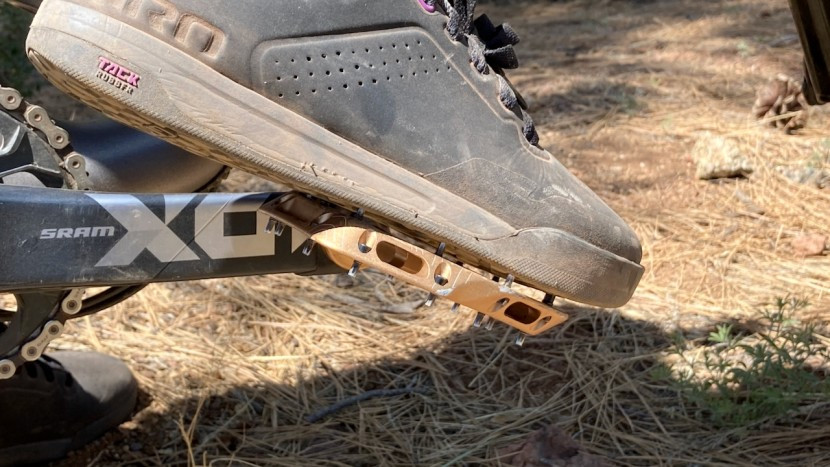 Bike pedal platform and materials
Bike pedal platform and materials
How to Pick the Best Bike Pedals
Bike pedals are essential for cycling, providing the platform that allows your feet to drive the cranks and propel your bicycle. The pedal body, where your foot rests, is made from materials like plastic, aluminum, or carbon fiber.
Inside the pedal body is a hollow core housing the axle, which contains bearings allowing the pedal to rotate. Bearing quality affects pedal drag and spin smoothness. Some drag is beneficial to prevent uncontrolled spinning when your foot is removed. Bike pedals are side-specific—left and right—with threaded axles that screw into the crank arms using a wrench or hex key. Proper side installation is crucial to avoid cross-threading and damaging pedal or crank arm threads.
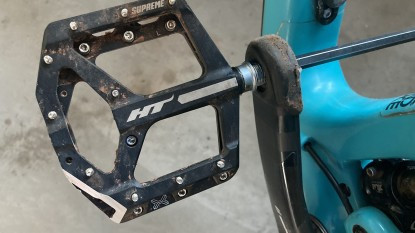 Bike pedal installation with hex wrench
Bike pedal installation with hex wrench
There are three main types of bike pedals: flat pedals (for mountain, cruiser, and general use), clipless mountain bike pedals, and road bike pedals, each with distinct advantages and disadvantages.
Why “clipless” pedals if they clip to shoes? The term “clipless” is a historical reference. Older cycling used “clips” or toe cages to secure feet to flat pedals. When systems attaching shoes directly to pedals were invented, they eliminated the need for toe clips, hence “clipless.”
Clipless mountain bike and road bike pedals require specific cycling shoes with soles designed to accept cleats. These cleats engage with the pedal mechanism, creating a secure shoe-pedal connection. Flat pedals have textured surfaces or pins for shoe grip and work with most athletic shoes or cycling-specific flat pedal shoes. Flat pedals and clipless mountain bike pedals are versatile for various bike types, while road bike pedals are typically used for road cycling due to the specialized, less walkable shoes they require.
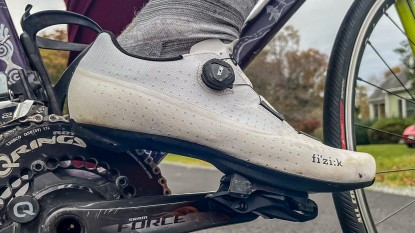 Road bike pedals and cleated shoes
Road bike pedals and cleated shoes
Mountain Bike Clipless Pedals
Clipless pedals, despite their name, use a cleat attached to the shoe sole that clips into the pedal mechanism, creating a secure connection. Mountain bike clipless cleats are generally recessed, allowing for easier walking. These pedals are favored for their ease of use, mud and dirt shedding, and walkability, making them popular for commuters, gravel riders, mountain bikers, and even some road cyclists. Many are double-sided for easy entry. Users appreciate the enhanced power transfer and secure feel of clipless mountain bike pedals.
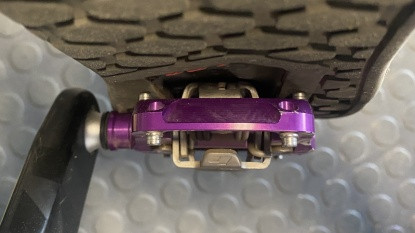 Recessed cleat box in mountain bike shoe
Recessed cleat box in mountain bike shoe
Most mountain bike clipless pedals use a spring-loaded mechanism. To engage, the front of the cleat is inserted, followed by downward pressure on the heel to secure the rear. Release is typically achieved by twisting or lifting the heel. Many pedals offer adjustable release tension.
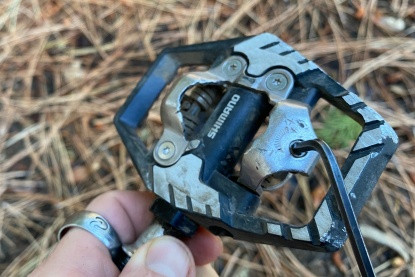 Adjustable tension on clipless mountain bike pedal
Adjustable tension on clipless mountain bike pedal
Some clipless mountain bike pedals incorporate a pedal body around the clipless mechanism, providing a platform for cleat guidance and shoe sole support. These bodies can be plastic, metal, or carbon fiber, affecting price and durability, with plastic being generally more affordable than aluminum or carbon fiber.
 Mud shedding design of mountain bike pedal
Mud shedding design of mountain bike pedal
Flat Pedals
Flat pedals are the most common and versatile pedal type globally. From cruisers to mountain bikes, flat pedals offer a large, stable platform without requiring special shoes. They are popular for their ease of use and the freedom to quickly put a foot down, beneficial for beginners, technical terrain, and stop-and-go commuting.
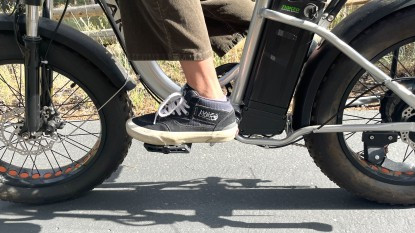 Flat pedals for versatile cycling
Flat pedals for versatile cycling
Flat pedal platforms utilize composite materials like nylon or aluminum. Pins, screws, ridges, or textured surfaces enhance shoe grip. High-end mountain bike flat pedals often feature replaceable pins, as these can be damaged by impacts.
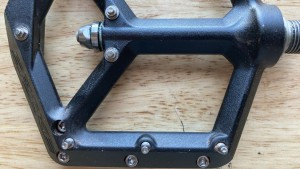 Composite nylon flat pedal with pins
Composite nylon flat pedal with pins
While versatile, flat pedals pair best with flat-soled shoes. Mountain bike flat pedal shoes are designed with stiffer soles and specialized rubber for enhanced grip and vibration damping, preventing foot fatigue and discomfort.
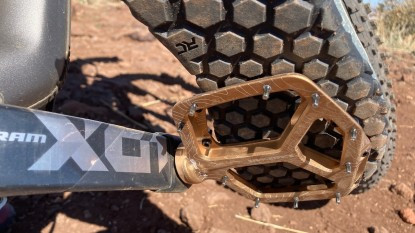 Pins on mountain bike flat pedals and shoe sole
Pins on mountain bike flat pedals and shoe sole
Road Bike Pedals
Road bike pedals are the most specialized type, utilizing a clipless system with a large, protruding cleat. These cleats, while efficient on the bike, are less walkable, often requiring cleat covers for walking.
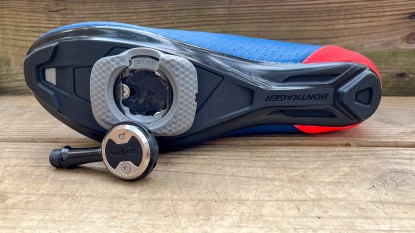 Road bike cleats protruding from shoe sole
Road bike cleats protruding from shoe sole
Road cyclists favor road bike pedals for their fixed foot position, maximizing power transfer and pedaling efficiency. Entry involves engaging the cleat’s leading edge and pressing down to secure the rear. Release is by twisting or pulling up the heel. Adjustable tension is common, allowing riders to customize release force.
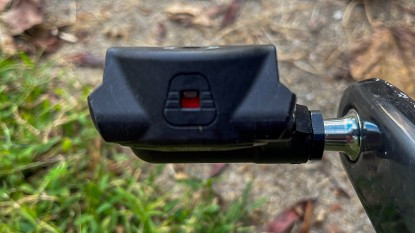 Adjustable tension on road bike pedals
Adjustable tension on road bike pedals
Road bike pedals are typically single-sided. Platform designs vary, with some using pedal bodies (composite or metal) and others relying on the cleat for the platform.
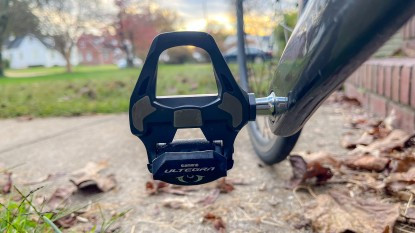 Single-sided road bike pedals with adjustable tension
Single-sided road bike pedals with adjustable tension
Conclusion
Choosing the right bike pedals is a personal decision. Select pedals that match your riding style and needs, considering factors beyond their “intended” use. Mountain bike clipless pedals can work well on road bikes, and flat pedals are suitable for commuters and even road bikes. Evaluate your riding conditions and whether you prefer clipless security or the freedom of flat pedals without cycling-specific shoes. Explore our in-depth reviews for each pedal type to aid your purchase decision and find your best bike pedals.

